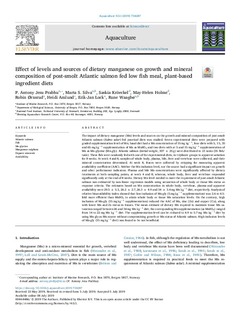| dc.description.abstract | The impact of dietary manganese (Mn) levels and sources on the growth and mineral composition of post-smolt Atlantic salmon (Salmo salar) fed practical diets was studied. Seven experimental diets were prepared with graded supplementation level of Mn; basal diet had a Mn concentration of 15 mg kg−1, four diets with 5, 15, 35 and 65 mg kg−1 supplementation of Mn as MnSO4 and two diets with at 5 and 15 mg kg−1 supplementation of Mn as Mn-glycine (Mn-gly). Atlantic salmon (initial weight, 307 ± 25 g) were distributed to 21 tanks (35 fish/tank). These fish were randomly fed with one of the experimental diets, in triplicate groups to apparent satiation for 8 weeks. At week 4 and 8, samples of whole body, plasma, bile, liver and vertebrae were collected, and their mineral concentration determined. At week 8, feaces were collected by stripping for measuring apparent availability coefficient (AAC). Neither the Mn inclusion level, nor the source had a significant impact on growth and other performance indicators. Plasma and bile Mn concentrations were significantly affected by dietary treatments at both sampling points, at week 4 and 8; whereas, whole body, liver and vertebrae responded significantly only at the end of 8 weeks. Dietary Mn level needed to meet the requirement of post-smolt Atlantic salmon was estimated by non-linear regression models using saturation of whole body or tissue Mn status as response criteria. The estimates based on Mn concentration in whole body, vertebrae, plasma and apparent availability were 29.5 ± 5.3, 26.2 ± 2.7, 26.3 ± 4.9 and 34 ± 3.4 mg Mn kg−1 diet, respectively. Analysis of relative bioavailability index showed that low inclusion of Mn-gly (5 mg kg−1 supplementation) was 2.6 to 4.5-fold more efficient than MnSO4 to attain whole body or tissue Mn saturation levels. On the contrary, high inclusion of Mn-gly (15 mg kg−1 supplementation) reduced the AAC of Mn, zinc (Zn) and copper (Cu), along with lower Mn and Zn status in tissues. The mean estimate of dietary Mn required to maintain tissue Mn saturation ranged between 26 and 34 mg Mn kg−1 diet; the corresponding Mn supplementation (as MnSO4) ranged from 14 to 22 mg Mn kg−1 diet. The supplementation level can be reduced to 4.9 to 5.7 mg Mn kg−1 diet by using Mn-gly as Mn source without compromising growth or Mn status of Atlantic salmon. High inclusion levels of Mn-gly (15 mg kg−1 diet) was found to be not beneficial. | nb_NO |
